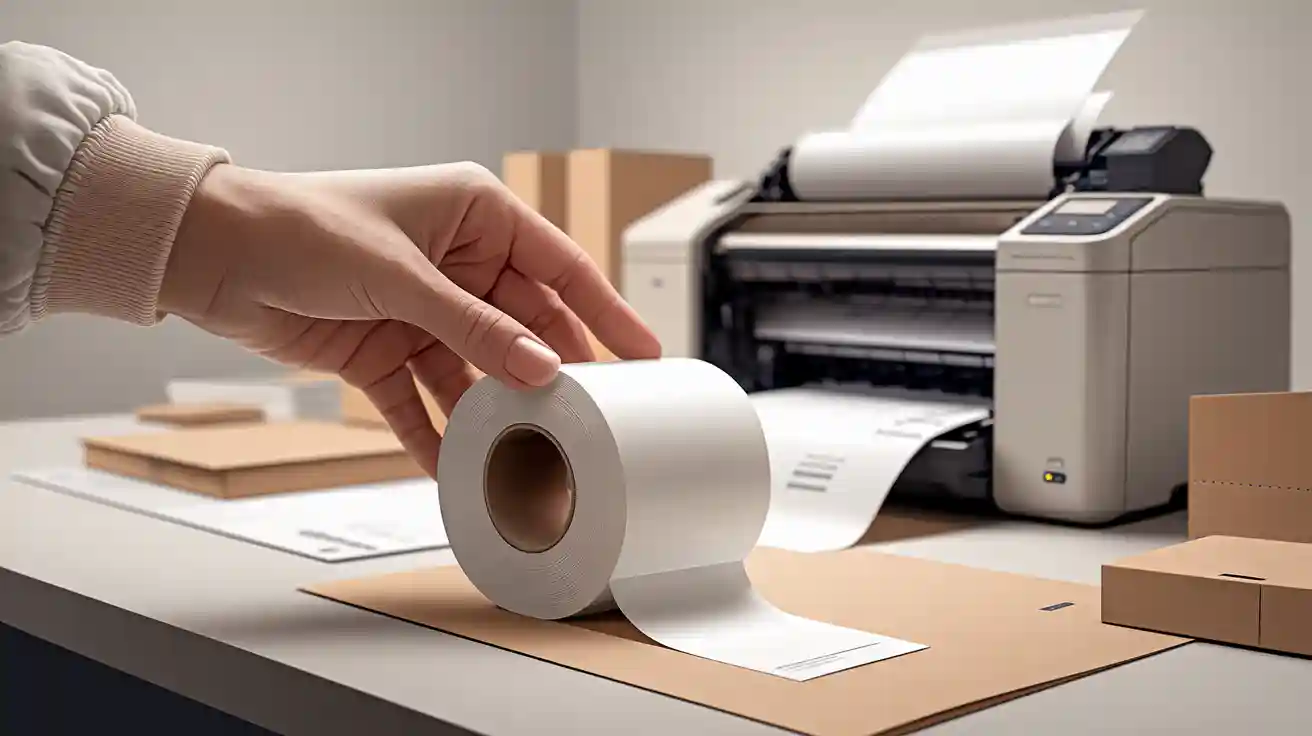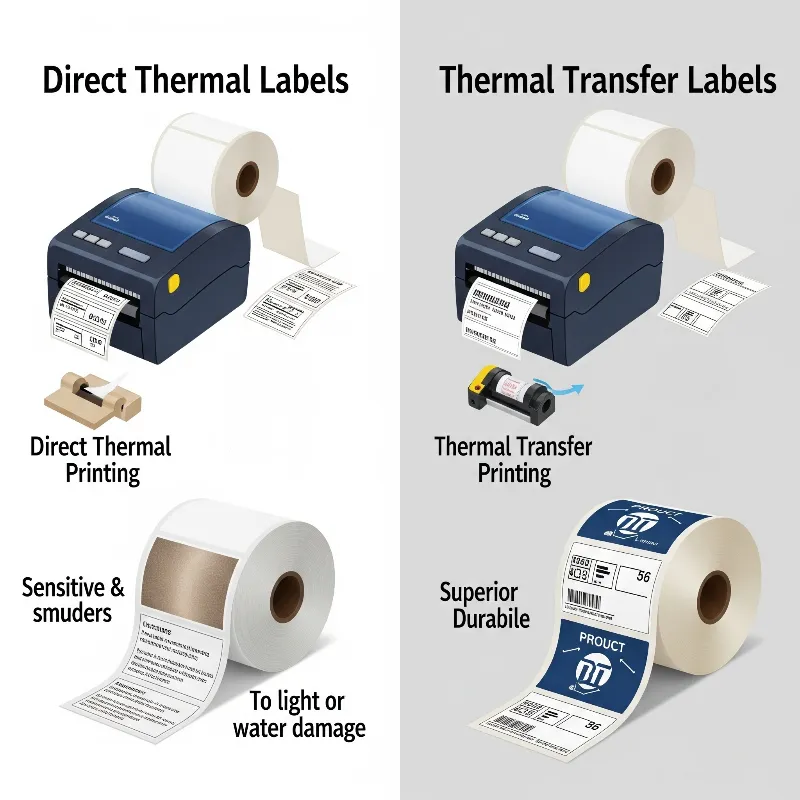
No, you should not use direct thermal labels with a ribbon. These labels have a special heat-sensitive coating. The printer uses heat to create images or text directly on the label surface. If someone tries to use a ribbon, the print may look poor and supplies may go to waste.
Key Takeaways
Direct thermal labels use heat to change their coating. They do not need ribbons or ink to print.
If you use a ribbon with direct thermal labels, the print will look bad. It also wastes supplies and can hurt the printer.
Direct thermal labels are good for short-term jobs like shipping labels and receipts. But they fade faster than thermal transfer labels.
Always use the right label type for your printer. Keep labels in a cool, dry place so prints stay clear and last longer.
Clean your printer often and use the right supplies. This saves money, cuts down on waste, and keeps your labels looking good.
Why No Ribbon?
How Direct Thermal Labels Work
Direct thermal labels use a special heat-sensitive coating to create images. The coating contains a mixture of dye and a chemical matrix. When the printhead heats up, it touches the label and causes a chemical reaction. The dye changes color and forms the image or text. This process is called thermochromism. The printhead has tiny heating elements that turn on and off quickly. Each element heats a small spot on the label. The heat makes the coating darken only where needed, so the printer can create barcodes, text, or pictures in one step.
Note: Direct thermal labels do not need a ribbon or ink. The product documentation confirms that these labels print images without any ribbon. This makes them different from thermal transfer labels, which always need a ribbon to work.
The printhead contains many small heating elements.
The label has a chemical coating that reacts to heat.
The printer heats certain spots to make the image appear.
No extra supplies like ribbons or ink are needed.
Printhead and Label Contact
The printhead touches the label directly during printing. This direct contact helps the heat move quickly from the printhead to the label’s coating. The heat causes the coating to react and form the image. Because the printhead rubs against the label, it can wear down over time. Dust or dirt on the label can stick to the printhead and cause problems. Sometimes, this leads to lines or missing spots in the print. The printhead for direct thermal labels usually lasts for about 160,000 to 325,000 labels before it needs to be replaced. In comparison, thermal transfer printers use a ribbon that protects the printhead and helps it last longer.
Direct thermal labels are also sensitive to heat, light, and humidity. If someone stores them in a hot or sunny place, the labels may fade or turn yellow. Most direct thermal labels last 12 to 24 months if stored properly, but harsh conditions can make them wear out faster.
If You Use a Ribbon
Print Defects
If you use a ribbon with direct thermal labels, the print will look bad. These labels have a coating that reacts to heat from the printhead. The ribbon does not stick well to this coating. This can make the printer create smudges, white spots, or missing parts on the label. The ribbon might wrinkle or slip, making jagged edges and extra lines. These problems make barcodes hard to scan and words hard to read.
Print problems happen because the ribbon and label do not work together. The ribbon might not put ink on the label right, or it might wrinkle if the pressure is not even. This can scratch the label and wear out the printhead faster.
Here is a table that lists common print problems and what causes them:
Print Defect Type | Common Causes | Suggested Solutions |
|---|---|---|
Jagged Edges | Ribbon does not match the label | Use the right ribbon and label |
Spots or Voids | Bad label or wrinkled ribbon | Change the label or fix the ribbon |
Unwanted Lines | Wrinkled label or ribbon | Make sure both are smooth |
Ribbon Wrinkling | Bad alignment or uneven pressure | Fix the alignment and pressure |
Ribbon Slippage | Happens on shiny labels | Use a different label or fix the tension |
Added Costs
Using a ribbon with direct thermal labels costs more money. Direct thermal printing does not need ribbons, ink, or toner. If you use a ribbon, you pay for something you do not need. This makes printing cost more but does not make it better.
Ribbons are made for thermal transfer printing, not direct thermal printing. Buying and throwing away extra ribbons wastes money and materials.
Extra ribbons also make more trash. Most ribbons are made of plastic that does not break down. Throwing away used ribbons fills up landfills and can hurt nature. The ink and chemicals in ribbons can also pollute the ground and water if not handled right. By not using ribbons with direct thermal labels, people save money and help the earth.
Direct Thermal Labels vs. Thermal Transfer

Technology Differences
Direct thermal and thermal transfer printing work in different ways. Direct thermal printing uses a label that changes color when heated. The printhead gets hot and touches the label. The coating on the label turns dark to make words or pictures. Thermal transfer printing uses a ribbon instead. The printhead heats the ribbon, and ink from the ribbon sticks to the label.
Aspect | Direct Thermal Printing | Thermal Transfer Printing |
|---|---|---|
Heat-sensitive label changes color when heated | Heated printhead melts ink from ribbon onto label | |
Consumables | Only special labels needed | Requires ribbon and compatible label |
Durability & Longevity | Durable, resists heat, chemicals, and abrasion | |
Application Suitability | Best for receipts, shipping, and short-term labels | Used for product ID, inventory, and long-term labels |
Print Quality | Sharp but less resistant to damage | High-definition, long-lasting images |
Maintenance & Cost | More supplies, higher cost, longer printhead life | |
Environmental Sensitivity | Fades with heat, sunlight, and abrasion | Withstands heat, moisture, and chemicals |
Durability and Use Cases
Direct thermal labels are good for things that do not need to last long. They usually last six to eight months. If they get too much heat, sun, or rubbing, they can fade. These labels work best inside or in places where the air is not too hot or wet. Thermal transfer labels last much longer, sometimes up to two years. They do not fade easily and can handle water, chemicals, and rough use. People pick thermal transfer labels for outdoor jobs, tracking products, and medical tools.
Tip: Pick thermal transfer labels if you need them to last or if they will be in tough places.
People use direct thermal labels for:
Barcodes in warehouses
Store and ATM receipts
Short-term inventory tags
Patient wristbands in hospitals
Thermal transfer labels are used for:
Product ID
Lab and medical labeling
Outdoor and factory labeling
Direct Thermal Labels: Short-Term Use
Direct thermal labels are easy and cheap for short jobs. They do not need ribbons or ink, so they are simple to use. Most shipping labels and receipts use this way because they only need to last a few weeks or months. How long they last depends on where you keep them. If you store them in a cool, dry, and dark place, they last longer. If they get hot or are in the sun, the print can fade fast.
Shipping and delivery companies use direct thermal labels for quick, clear labels.
Stores use them for receipts and price tags.
Warehouses use them for short-term inventory and bin labels.
Direct thermal labels help save money and make less trash for short jobs. If you need labels to last a long time, thermal transfer printing works better.
Choosing the Right Label
Identifying Label Types
Choosing the correct label type starts with knowing how to tell them apart. Direct thermal labels and thermal transfer labels look similar, but they react differently to heat. People can use a few simple tests to identify them:
Try the scratch test. Rubbing a coin or fingernail on a direct thermal label often leaves a black mark. This shows the label has a heat-sensitive coating.
Use the heat test. Holding a warm object, like a heated spoon, close to the label will darken a direct thermal label. Thermal transfer labels do not change color with heat.
Check the packaging. Most label rolls list if they are direct thermal or thermal transfer.
Look for a ribbon in the printer. If the printer uses a ribbon, it likely needs thermal transfer labels.
Tip: Direct thermal labels do not need a ribbon. If a label darkens with heat or scratching, it is probably direct thermal.
Best Practices
Selecting the right label and printing method helps avoid wasted supplies and poor print quality. People should follow these steps:
Match the label type to the printer. Use direct thermal labels only in direct thermal printers. Use thermal transfer labels with a ribbon in thermal transfer printers.
Choose the right label material for the job. Paper labels work well indoors. Polypropylene and polyester labels last longer and resist water or chemicals.
Check label size and core. Make sure the label width, roll diameter, and core size fit the printer.
Read the printer manual. Manuals explain which labels work best and how to load them.
Store labels in a cool, dry place. This keeps them from fading or sticking together.
Maintain the printer. Clean the printhead and rollers to prevent jams and print defects.
Common Mistake | How to Avoid |
|---|---|
Always check printer and label compatibility | |
Picking the wrong label for the environment | Choose materials that match where the label will be used |
Ignoring printer maintenance | Clean and check the printer often |
Following these steps ensures clear, long-lasting labels and saves money.
Direct thermal labels should be used without ribbons. Experts say not using ribbons saves money and makes less trash. It also helps things move faster at work. People need to use the right label with the right printer for good results. They should check their labels and printer before printing to stop mistakes.
Tip: Cleaning the printer often and doing test prints can stop problems and keep prints looking good.
FAQ
Can direct thermal labels work in any printer?
Direct thermal labels only work in direct thermal printers. These printers use heat to make images on the label. Thermal transfer printers need a ribbon and different labels.
What happens if someone uses a ribbon with direct thermal labels?
The print may look faded or have missing spots. The ribbon does not stick to the label coating. This can waste supplies and cause poor print quality.
How can someone tell if a label is direct thermal?
A person can scratch the label with a coin. If a black mark appears, the label is direct thermal. The label may also darken when heated.
Are direct thermal labels safe for outdoor use?
Direct thermal labels do not last long outdoors. Sunlight, heat, and moisture can make them fade quickly. For outdoor use, thermal transfer labels work better.
